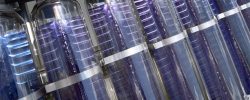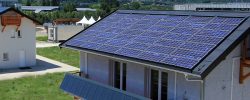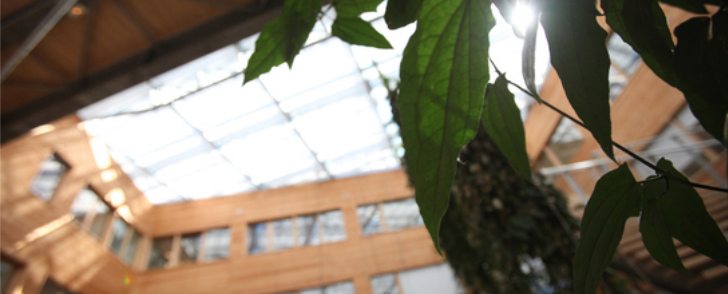The National Solar Energy Institute (INES) brings together research staff from the CEA, as well as from the University of Savoie (USMB), the CNRS and the CSTB. The institute’s laboratories, clean rooms, pilot facilities and demonstrators allow its scientists and technicians to work on optimizing all aspects of solar photovoltaic energy, from cells to systems and from positive-energy buildings to solar mobility. In addition to carrying out research into solar photovoltaic energy, teams are being set up to study solar thermal energy for cooling and heating, and to investigate ways of optimizing passive energy through energy management in buildings and energy efficiency technologies.
INES’s research teams investigate all aspects of solar photovoltaic energy – silicon materials, cells, modules, systems, electricity storage, demonstrations and tests. The institute’s scientists are currently studying methods for producing solar-quality silicon metal, increasing the efficiency of solar cells and developing storage systems for innovative forms of energy.
In the field of solar thermal, R&D will be carried out to optimize existing products and to adapt these products according to their usage or the complementary energy used (wood, gas, etc.). Other research fields include the development of combined systems (hot water and heating) and solar climate control.
Building-integrated solar energy and the active management of combined thermal and electrical sources are also major research streams for INES, whose objective is to develop “positive energy” technologies that produce more energy than they consume.
INES is also carrying out important research into solar mobility.

The photovoltaic solar platform’s mission is to contribute to the development of the solar industry in France. And, with more than 200 employees from CEA and 100 industrial partners from SMEs to corporations, the platform is one of Europe’s largest PV R&D facilities.
The platform’s PV R&D focuses on materials, with particular attention given to developing high performance, competitively-priced silicon; PV cell technology and yield enhancement; and solar modules and optimization. Applied research takes place at experimental PV facilities and at reduced-scale and life-sized solar power plants.
- 200 researchers and technicians
- Heterojunction LabFab, materials platform, PV module platform, CPV platform, organic PV platform, and outdoor experimentation platform
- 15000 m2 of facilities
- 100M€ of investment

The thermal technology platform is unique in Europe, in terms of both its size and the scope of its R&D activities, which span technologies to produce thermal energy (concentrated solar power), store it for later use, and use it efficiently for industrial applications like heat pumps, boilers, and thermal exchangers.
The R&D carried out at the platform involves around 50 industrial partners, including major corporations like GDF Suez, Saint Gobain, Total, and Renault. These partners hope to improve the energy performance of their industrial processes by optimizing heat transfer and by introducing thermal storage systems.
The platform possesses an extraordinary range of equipment: two concentrated solar power plants of more than 1,000 sq.m, around 20 instrumented test loops, and thermal storage demonstrators (phase-change-material on a highpressure steam circuit, oil on rock bed, and stacked ceramic on a high-temperature—up to 1,200°C—air circuit).
- 75 engineers and technicians
- Notable equipment: the Cadarache CSP plant with 1,300 sq. m of mirrors, a 450°C steam turbine, and three-stage thermal storage
- €15 million in investment
- The R&D carried out at the platform involves around 50 industrial partners, including major corporations like GDF Suez, Saint Gobain, Total, and Renault
- 1,500 sq. m 5ha of prototypes
- 6O patents, 15 patent applications P.A

Building energy management will be a prime factor in meeting France’s commitment to reduce greenhouse gases and to find alternatives to fossil fuels. The objective is to optimize energy use without sacrificing comfort or quality of use.
The introduction of buildings with very high levels of insulation poses specific problems in terms of design and the prediction of dynamic performance. In addition, it is just as important to ensure comfort in summer as in winter, and to take into account the contribution of internal sources of heat and passive solar energy. Achieving this will require both new ways of modeling and simulating the dynamic energy performanceof buildings and the introduction of new modes of energy management. Such global management will involve a wide range of relatively complex tools, each of which requires quite detailed modeling of a building.
Because experimental data are needed to calibrate these models, INES has set up a unique experimental center, INCAS, to carry out tests on fully instrumented experimental houses with envelopes that have different degrees of inertia.
Research is also being carried out into optimizing the performance and operation of building-integrated thermal and electrical systems, while taking into account parameters such as thermal comfort, lighting (natural and artificial) and air quality. The objective is to develop specific tool kits for the building industry that will allow energy management to be integrated into buildings from the design phase.
